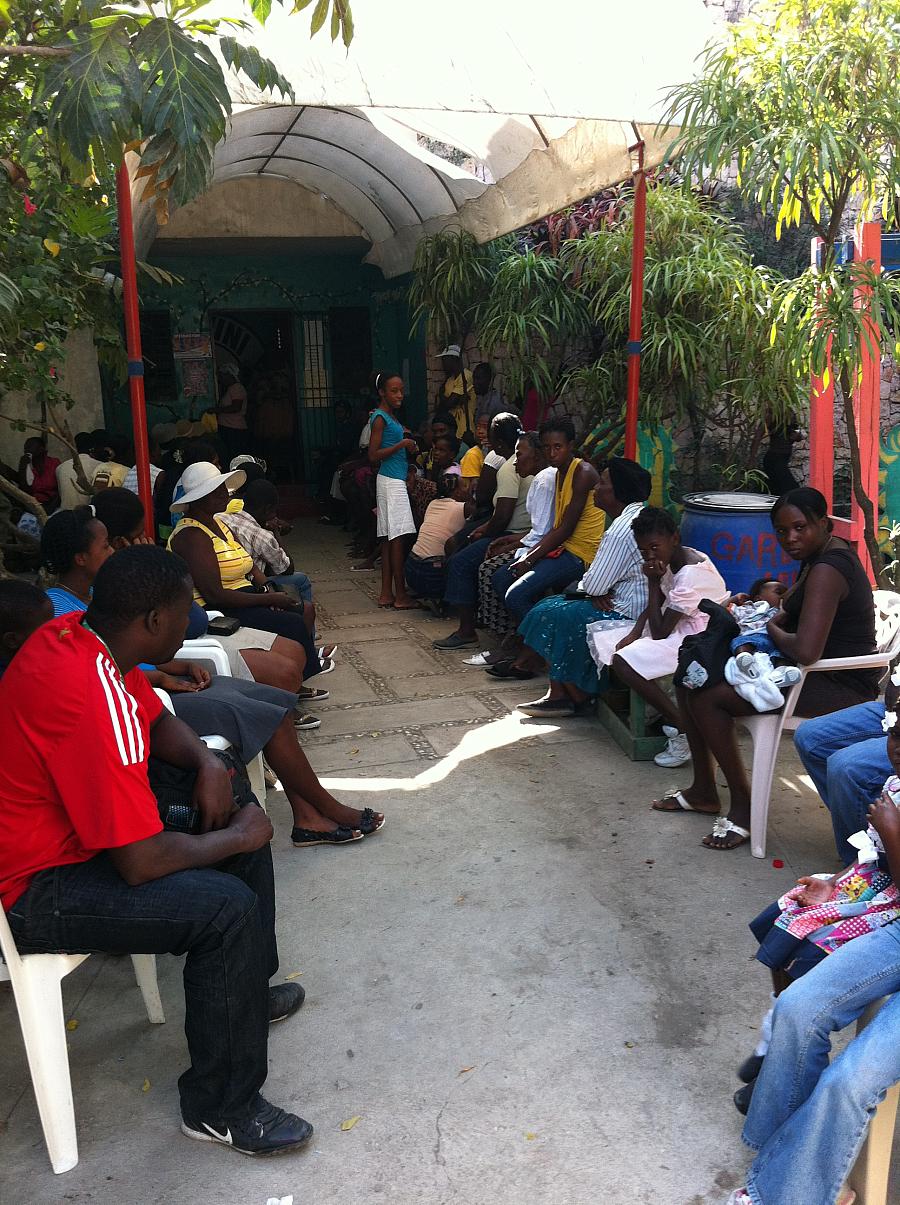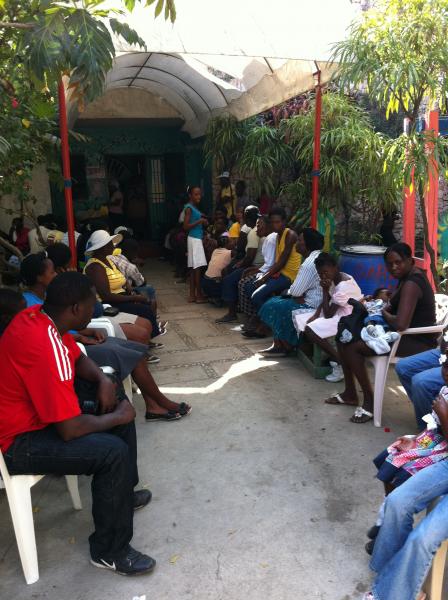Diabetes in Post-Earthquake Haiti: An American Doctor's Experience

Editor's note: Noted diabetes specialist and researcher Francine Kaufman is in post-quake Haiti to provide diabetes care. Here are some of her initial observations, with more to come on Tuesday.
 Haiti looks better. There is less rubble, less desperation and more hope. But there are still tents cities everywhere, the biggest of them across from the collapsed Presidential Palace. Buildings that fell to the ground from the earthquake are still all around, but a few have been cleared since last year. All commerce is essentially still on the sidewalks, and traffic is a mess. We feel safe, even though we probably aren't, so we are being cautious.
Haiti looks better. There is less rubble, less desperation and more hope. But there are still tents cities everywhere, the biggest of them across from the collapsed Presidential Palace. Buildings that fell to the ground from the earthquake are still all around, but a few have been cleared since last year. All commerce is essentially still on the sidewalks, and traffic is a mess. We feel safe, even though we probably aren't, so we are being cautious.
We have been here for three days, but it seems like a lifetime. When we arrived in the airport, it was chaos. Finding our host – epidemiologist Dr. Phillipe Larco, the husband of Dr. Nancy Larco, MD – the endocrinologist who runs FHADIMAC, the Haitian Diabetes Association, and who we came to work with) – was an arduous task, as we were jostled and harangued by a throng of Haitian men trying to help us so that we would pay them a dollar.
We had already met up with Carol and Mark Atkinson from Gainesville, Florida in Miami and flew to Port Au Prince together. I have known Mark for years – he is one of the most important type 1 diabetes researchers in the world, having helped define and characterize the autoimmune process that causes this disease.
Mark and Carol have worked in Haiti for 15 years, making more than 15 trips to go to one of the mountainous areas where they are helping bring a village to health and more than subsistence living. They have cared for children, built a clinic, brought in doctors and dentists and carpenters and engineers and equipment. They have transformed the world for the people in the village.
They joined us on this trip to see more about FHADIMAC, the Haitian Diabetes Association. Waiting for us in the hotel was Evelyne Fleury-Milfort, the gifted wonderful diabetes educator originally from Haiti who has been our inspiration to come to and work with in Haiti. We were joined by Merith Basey, who helps run AYUDA, a group we have worked with for 13 years. AYUDA runs diabetes camps in Ecuador and the Dominican Republic and offers youth leadership training for young adults with diabetes around the world.
We have been busy since arriving. We taught at the Notre Dame Medical School. I lectured on diabetes to a group of medical students in their final year of school. They were interested, aware, able to understand English, and asked great questions. We didn't visit this medical school, the best in the country, last year, and we all feel these students have great potential. We have begun to explore if there might be some exchange in the future after talking to their very impressive dean.
We met with four people from the Ministry of Health. We discussed long-range plans for diabetes, and particularly the role of FHADIMAC. FHADIMAC runs the Life for a Child Program in Haiti, an international program that brings supplies a year at a time to poor children with diabetes in under-resourced countries across the globe.
FHADIMAC runs a clinic for adults with diabetes and charges them a dollar, screens people across this country to find out if they have diabetes, teaches, organizes and helps other clinics take care of people with diabetes. FHADIMAC wants to be the go-to diabetes group and to continue to work with the new Ministry of Health – all those officials appointed since the elections less than a year ago.
Today we went to the clinic in Leogane. The clinic is located at the epicenter of the earthquake and is run by an American, Jason Stowell, who is a carpenter-builder. His group was here building furniture before the quake and happened to be located in the same compound as the Klinik Kominote (Community Clinic).
After the quake, the people running the clinic left and Stowell took over with the Haitian doctor who was there. They partnered with IsraAid, and as a result, there are three Israelis working in the clinic – a surgical resident, a nurse from Montreal (who was born in Israel) and a pediatric ICU nurse. They work side-by-side with Dr. Spencer's team of Haitians – a nurse, a pharmacist, a translator, and a clerk. And with the support of FHADIMAC, they are now an outreach diabetes clinic – having received protocols, training and the ability to enroll children with diabetes in Life for a Child.
The clinic was overrun with patients – of all ages and all levels of illness. I saw six adults with diabetes. One woman with a below-the-knee amputation of her left leg and foot had a festering ulcer at the side of her right foot that will likely take that leg as well. Another woman with type 2 diabetes weighed 310 pounds – her blood glucose was 320 – but she had already lost 15 pounds.
Most of the patients with diabetes had been coming to the clinic for some time, getting the appropriate meds, trying to follow the diet and taking diabetes seriously. There were many other patients; kids with asthma, babies with fevers, pregnant women – some happy about their pregnancies, some overwhelmed, one desperate with three kids already at the age of 25.
The tragedy of the day was a 67-year-old woman, who looked ill and in pain. She immediately showed us a huge lump in her breast. She held her head rocking back and forth; she likely has brain metastases.
The clinic was well run – the Israelis seemingly well-adjusted for their four-to-six month stints in Haiti. But there are challenges to this model, since the goal is to have a Haitian-run, Haitian-staffed clinic that doesn't rely on outside resources. A lot needs to be done before that is even remotely possible – from facility improvements to training and empowerment of the Haitian medical/nursing staff. While Neal, Mark, Carol and I were in clinic, Evelyne, Nancy and Merith went with some of the staff to screen 115 people from Leagone for diabetes. They found 14 with abnormal blood sugars, who all will be referred back to the Klinic Kominote.
The drive to and from Leogane was depressing, with people and squalor everywhere. Tents, rubble, trash, sewage, rivers overrun with garbage, and traffic harrowing and dangerous. As we drove, one man pried open the door of our van, but we quickly got him out. The pictures we took don't tell the full story of the still-overwhelming job facing this country to get adequate housing, safety and work for the masses.
Then we went up to the diabetes camp. It is located up in the mountains, where the well-off live. We will be running the camp in a beautiful church, and we were serenaded by the church choir practicing for Sunday mass. The kids were excited as they barreled off the bus, and tomorrow it starts in full. So we are going to collapse for the evening, I am going to look at everyone's diabetes management and I can tell already by the stunted growth and bloated bellies I saw on some of the kids, that my work is cut out for me.
We are having a great time, busy and excited. And with caution, staying safe...
Related Posts:
At Haiti Diabetes Camp, Kids Learn to Live With Their Disease (And Not Much Else)
Photo credit: Francine Kaufman

